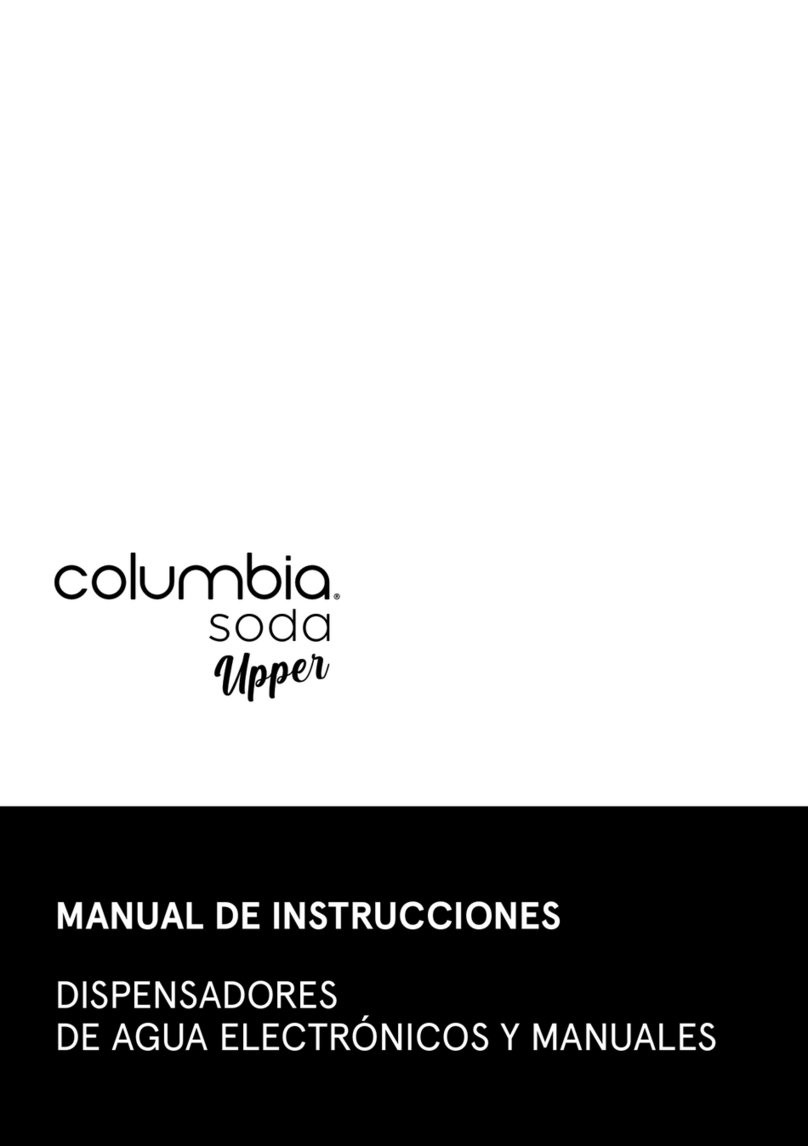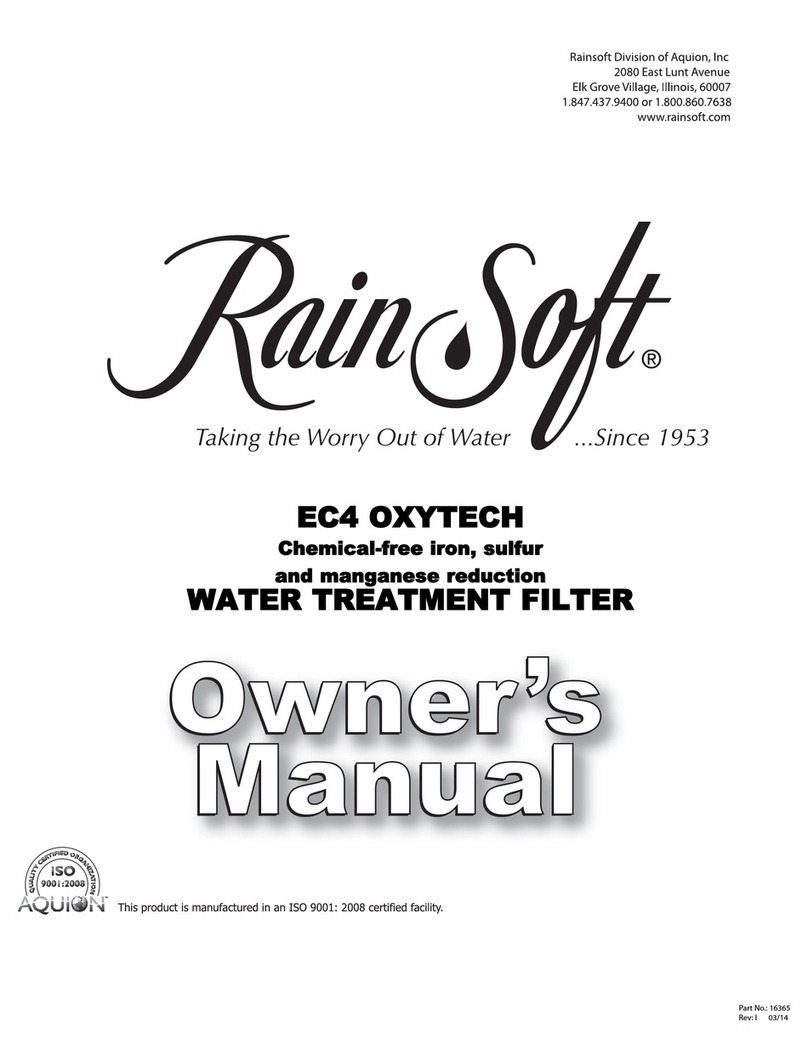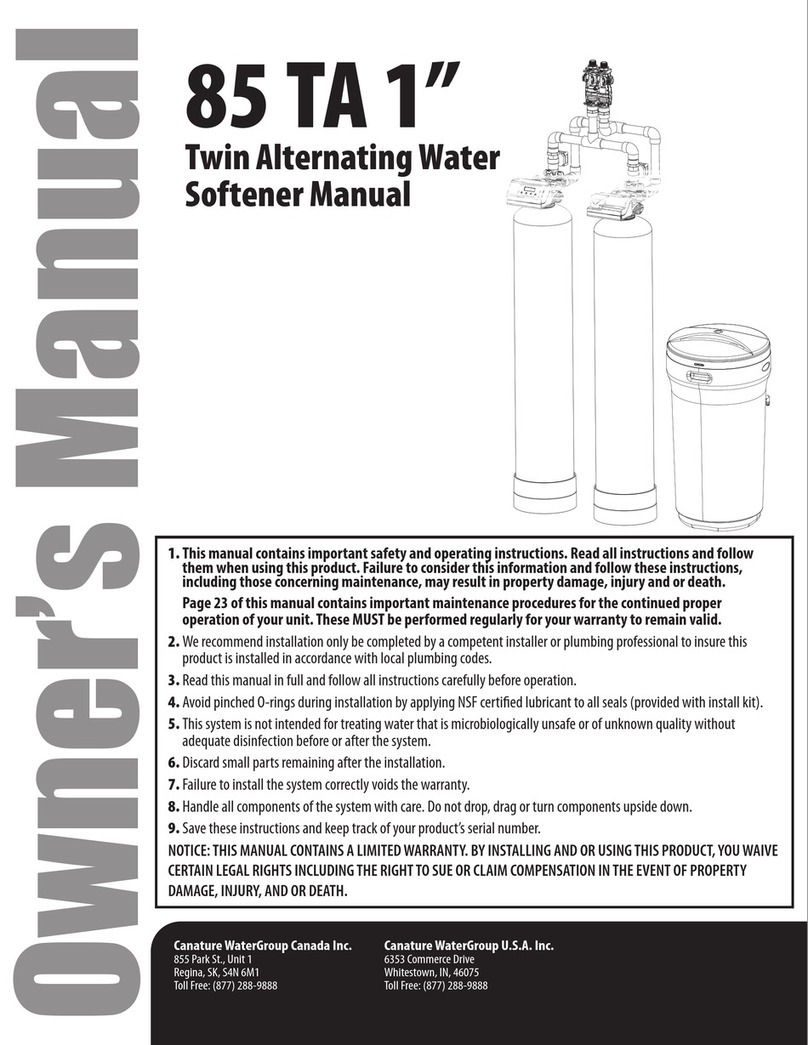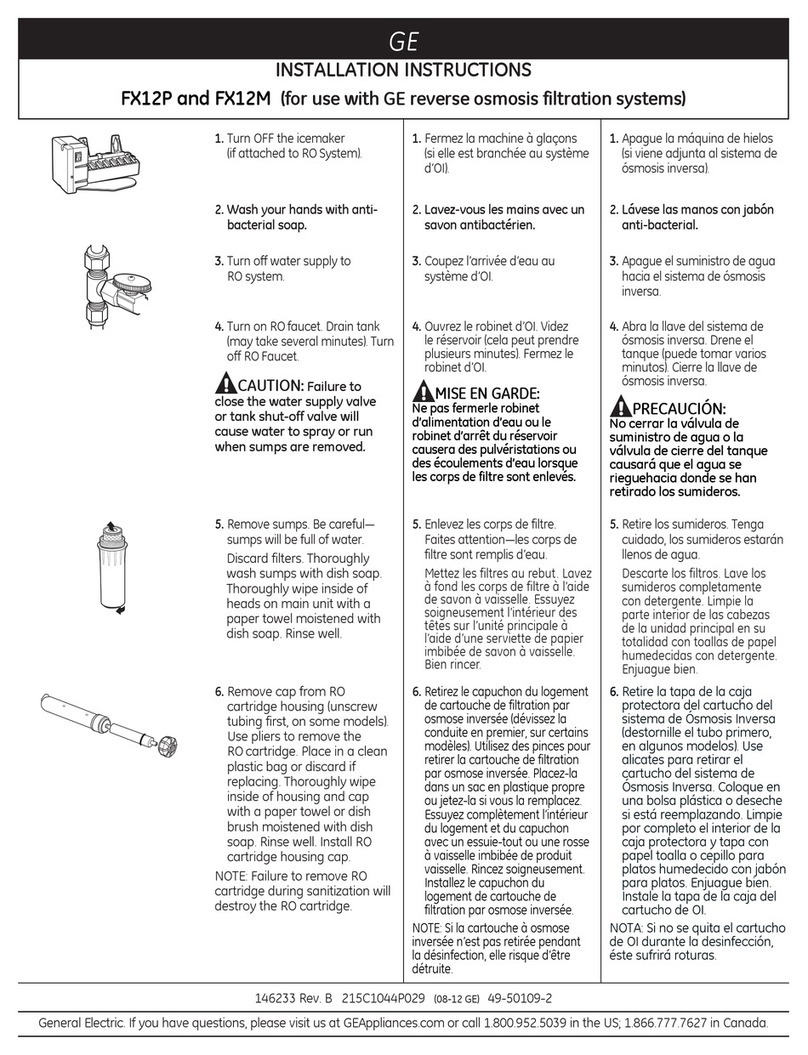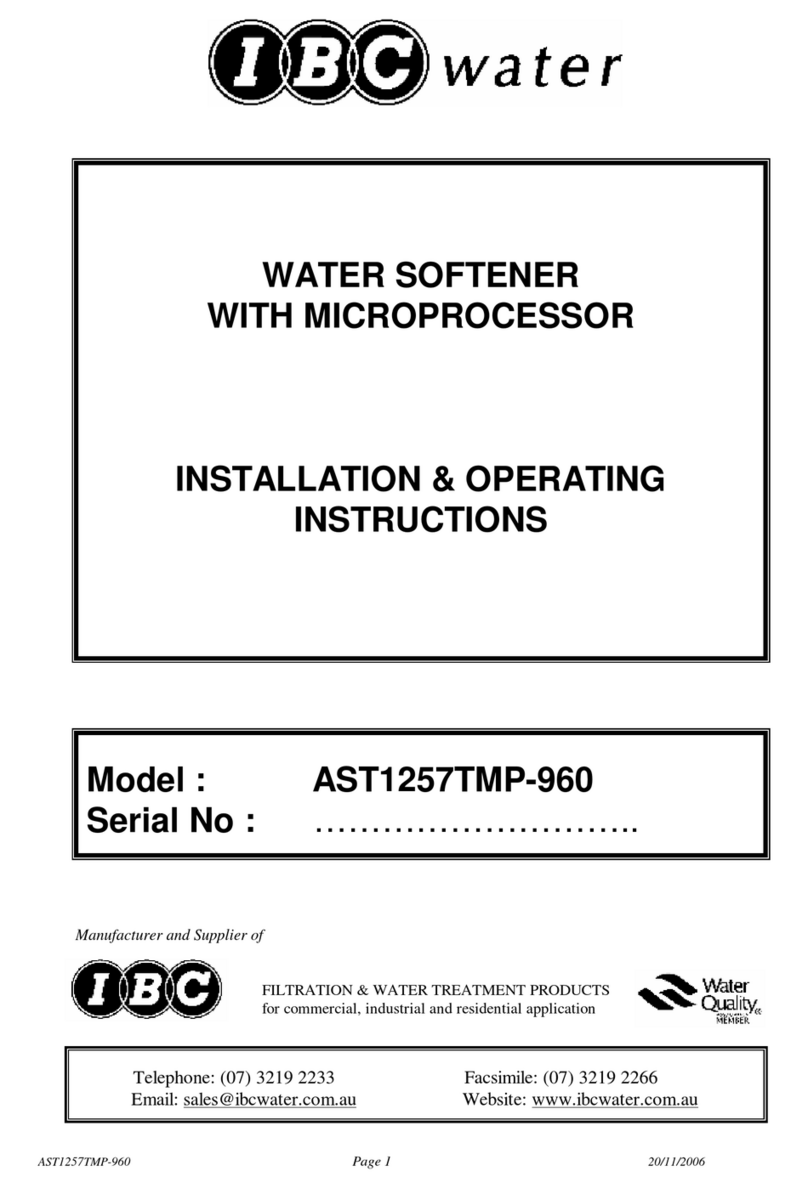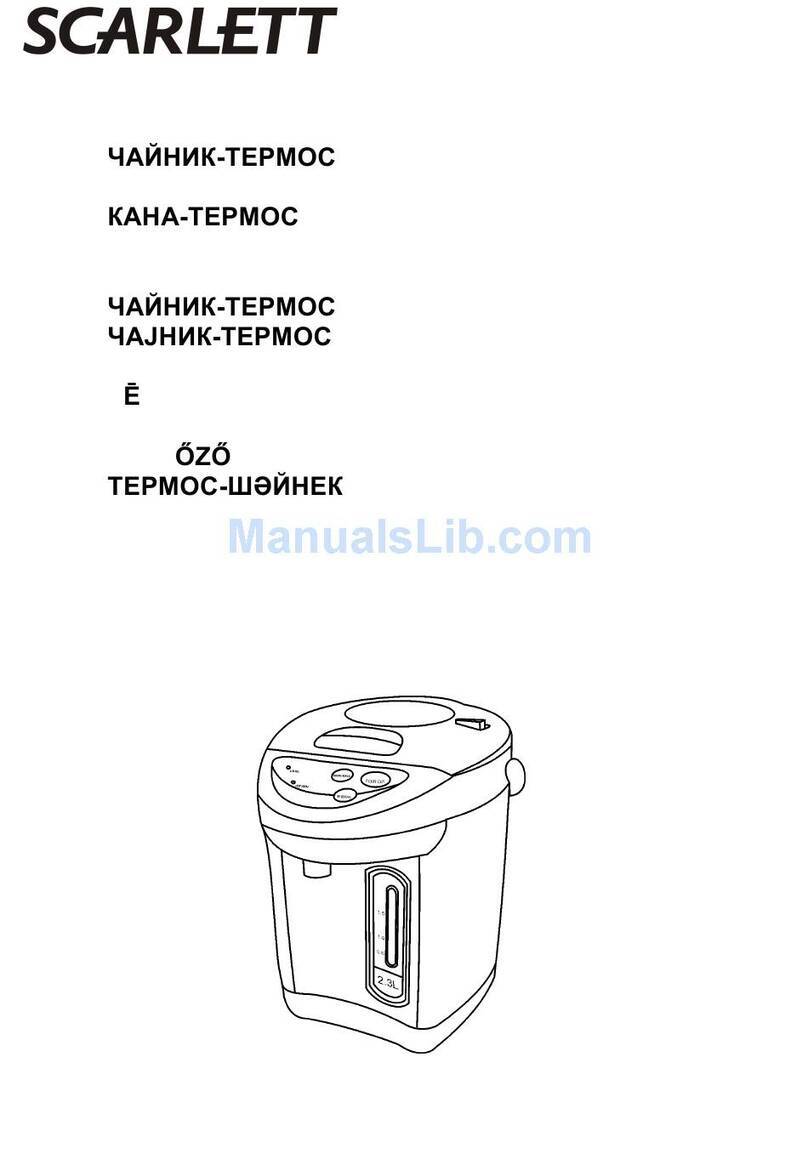IONFILTER LATT User manual

1
INSTRUCTION MANUAL
REVERSE OSMOSIS EQUIPMENT


CONTENTS P
1
2
3
4
User manual
Technical manual
Hygienisation procedure
Technical data
4
8
14
19

Manual de usuario
0. MAIN CHARACTERISTICS
Keep this manual, which includes the servi-
ce and warranty log sections, so that we can
provide you with a better after-sales service.
USER’S MANUAL
FOR REVERSE OSMOSIS SYSTEMS
CLICK
QUICK AND HIGH
SECURE CONNECTIONS
FILTER CONTROL
AUTOMATIC
MAINTENANCE NOTIFICATION
DOUBLE
FLOW
GREATER FLOW
OF WATER DISPENSED
SOLENOID
VALVE
INSTANT CONTROL
SAFETY MESH
DIRECT
ACCESS
EASY ACCESS
AND MAINTENANCE
AQUASTOP
AUTOMATIC LEAK
DETECTION SYSTEM
QUALITY
CONTROL
CONTROL
OF CONDUCTIVITY
DIRECT
FLOW
DIRECT PRODUCTION
OF RO WATER
LED
STAT US
STATUS
DISPLAYS
SOUND
WARNINGS
ACOUSTIC
WARNINGS
HIGH PERFORMANCE
MOTOR
HEAVY-DUTY
ENGINE
PRESSURE
CONTROL
PROTECTION AGAINST
PRESSURE DROPS
HIGH
EFFICIENCY
RECOVERY
IN PRODUCTION
SMART
FAU CE T
INTELLIGENT
TAP
EXCLUSIVE
MEMBRANE
ORIGINAL
MEMBRANE
ELECTRONIC
ADAPTER
INCREASED SAFETY
AND EFFICIENCY

5
1. INTRODUCTION
congratulations. You have purchased an excellent do-
mestic water treatment equipment.
This equipment will help you to improve the properties
of your water.
2. WHAT IS OSMOSIS?
The natural or direct osmosis is the most common in
nature, given that semi-permeable membranes are part
of the vast majority of organisms (for example plant
roots, organs of our own body, cell membranes, etc ...).
When two solutions of different salt concentrations are
separated by a semi-permeable membrane, in a natural
way, a flow of water is produced from the solution with
the lowest concentration to the one with the highest
concentration. This flow continues until concentrations
on both sides of the membrane are equal.
When this process is reversed to achieve a flow of water
with a lower salt concentration from a higher concen-
tration, sufficient pressure must be applied to the wa-
ter with the highest concentration on the membrane to
overcome the tendency and natural flow of the system.
This process is what we call reverse osmosis. Nowadays,
reverse osmosis is among the best methods to improve
the properties of water by means of a physical system
(without the use of chemical products).
The water to be treated exerts pressure on the se-
mi-permeable membrane, so that part of it will be able
to pass through the pores of the membrane (osmosis
water), while the rest of the water (rejected or with a
high concentration of salts) will be diverted to the drain
(Fig. 1).
3. PRECAUTIONS
ATTENTION: Read carefully the warnings des-
cribed in the corresponding section of the Tech-
nical Manual.
ATTENTION: This equipment is not a water puri-
fier. If the water to be treated comes from a pu-
blic supply (and therefore complies with current
legislation), this equipment will substantially improve
the quality of the water.
The water treatment plants require periodic mainte-
nance by qualified technical personnel in order to gua-
rantee the quality of the water produced and supplied.
3.1. USAGE OF EQUIPMENT
- When you will be gone for more than a week, close the
water inlet tap to the equipment, empty it and discon-
nect it from the power supply (PUMP model). When you
return, connect the power supply, open the entrance
tap and the faucet. Let the water flow for at least 5 mi-
nutes before consuming water.
ATTENTION: After an extended period (more than
one month) in which the equipment has been
found to be inoperative or not producing water,
contact your dealer for proper sanitation and mainte-
nance.
- Remove jars or full bottles and avoid occasional cup
extraction for better performance of the equipment.
ATTENTION: Special attention should be devoted
to the cleanliness and hygiene of the osmosis fau-
cet, as usual and especially at the time of periodic
maintenance and sanitization. To do this, use a dispo-
sable single-use sanitizing spray and kitchen towel.
Under no circumstances should the hand wipe or mul-
tipurpose cloth used for cleaning the kitchen be used.
3.2. RECOMMENDATIONS FOR THE APPROPRIATE USE OF
OSMOSIS WATER
- If you wish to feed any other consumption point with
osmosed water (such as a fridge with a bucket dispen-
ser, another tap, etc...), the channelling should not be
carried out with a metal tube, as this would give the
water a bad taste. Always use plastic tube.
ATTENTION: The water provided by the domestic
osmosis equipment is LOW MINERALIZATION. The
mineral salts needed by the human body are provided
mainly by food, especially dairy products and to a less
extent by drinking water.
- We recommend not to use aluminium utensils to cook
with osmosed water.
Membrana de ósmosis
Membrana
Contaminación Entrada de agua
Bacterias Presión sobre la membrana
Compuestos químicos Flujo del rechazo
Sales minerales Membrana
Agua Flujo del agua purificada
Agua purificada
Entrada Presión
Rechazo: agua con sales
y elementos retenidos

Manual de usuario
4. THE BASIC OPERATION
The mains water to be treated enters the equipment
through the sediment and carbon filter. In this filtration
stage the suspended particles, chlorine, its derivatives
and other organic substances are kept.
The passage of water into the equipment is controlled
by a solenoid shut-off valve.
The water, after being treated in the filtration stage,
is propelled towards the reverse osmosis membranes.
The equipment includes a pump to increase the pres-
sure, since the pressure of the water on the membrane
makes the reverse osmosis process possible.
The osmosed water flows out of the equipment throu-
gh the tap for consumption. The water waste or excess
salts and other dissolved substances is directed to the
drain for disposal.
When water is no longer required through the tap, the
equipment stops working by means of a maximum pres-
sure switch.
This equipment is equipped with a minimum pressure
switch as a safety system, which protects the pump
from pressure drops, stopping the equipment and pre-
venting it from running under vacuum.
5. USER INTERFACE
ATTENTION: This equipment comes with an elec-
tronic controller that will manage in an efficient
way, the functionality and indications of the state in
which it is, as well as the different security systems.
The technical data sheet of the equipment describes
the states in which the system can be found and the
information provided by it (pages 20-22 of this manual).
6. MAINTENANCE
In order to ensure the quality of the water supplied by
your equipment, it should be regularly maintained.
Read the corresponding section of the Technical Ma-
nual to see the maintenance frequency recommended
(page 11 of this manual).

7
7. IDENTIFICATION AND RESOLUTION OF PROBLEMS
Several possible causes.
1. No water supply.
2. No power supply.
3. Leak sensor activated.
1. Power key partially closed.
2. Filters / membrane in poor con-
dition or exhausted.
Several possible causes.
Several possible causes.
Air in the system. Micro air bubbles
that disappear after a few seconds.
Several possible causes.
1. No water supply.
2. No power supply.
3. Leak sensor activated.
Several possible causes.
1. Deteriorated inlet solenoid valve.
2. Anti-return of deteriorated pro-
duction.
Call for service.
1. Allow the supply to return.
2. Check your home’s power supply. If the
problem is still not solved, call for service.
3. Leak sensor activated. If the leak is unde-
tected, wipe the bottom of the equipment
together with the leak sensor. If it keeps ha-
ppening, call for service.
1. Open completely.
2. Call for service.
Call for service.
Call for service.
It is not a problem. The appearance will fade
as the air inside the equipment is removed.
Call for service.
1. Check the condition of the general key
and the entrance of the equipment.
2. Check the general power supply. If the
problem is not solved, call for service.
3. If the leak is not detected, dry the bottom
of the equipment along with the leak sensor.
If it recurs, call for service.
Call for service.
1. Check and replace.
2. Check and replace.
1. External leakage of
the equipment.
2. No production.
3. Low production.
4. Excessive produc-
tion.
5. Unpleasant taste
and smell.
6. Whitish water
color.
7. Continuous dripping
noise in drain.
8. Equipment does
not start.
9. The equipment
stops and starts
constantly.
10. Equipment cons-
tantly carries water
down the drain.
PROBLEMS POSSIBLE CAUSE SOLUTION
Read the INTERFACE section of the Technical Data Sheet. In case of malfunction, contact the SAT and proceed as
indicated: Close the entrance key. Open the tap to depressurise the system and then disconnect the plug.
Closed Open

Manual técnico
1. MAIN FEATURES
APPLICATION
Water treatment
Reverse osmosis
Usage
To improve the characteristics of drinking water (complying with the requirements of the European Drinking Water
Directive 98/83 or its national transpositions in the different Member States of the European Community).
Modifications by reduction or contribution
- Reverse osmosis water treatment is able to reduce concentrations of salts and other substances by high percentages.
- Minimum reduction* of certain compounds and parameters:
Sodium: 90%.
Calcium: 90%.
Sulphate: 90%.
Chloride: 90%.
Total hardness: 90%.
Conductivity: 90%.
* Depending on the characteristics of the water to be treated (at the exit of the membrane). These values may
vary depending on the type of post-filter incorporated in the equipment and/or regulation of the mixing valve (if
incorporated).
2. PRECAUTIONS
ATTENTION: the equipments ARE NOT WATER POTABI-
LIZERS. If the water to be treated comes from a public
supply (and therefore complies with current legisla-
tion), this equipment will substantially improve the quality
of the water.
ATTENTION: If the water to be treated does not come
from a public supply network or originates from an
unknown source, it will be necessary to carry out a
physical-chemical and bacteriological analysis of the water
to ensure its correct potabilisation by applying the techni-
ques and equipment appropriate to each need, PRIOR TO
THE INSTALLATION of the equipment. Contact your distribu-
tor for advice on the most suitable treatment for your case.
TECHNICAL MANUAL
FOR REVERSE OSMOSIS EQUIPMENT
OPERATIONAL LIMITS
PUMP UNIT
Pressure (max./min.):
TDS (max.):
Temperature (max./min.):
Hardness (max.):
4 bar - 1 bar (400kPa-100kPa) .
1500ppm.
38 ºC - 5 ºC.
15 ºHF. **
ATTENTION: If you have any questions regarding the installation, use or maintenance of this equipment, plea-
se contact your dealer’s technical support service ( S. A. T.).
2.1 CONDITIONS FOR THE CORRECT OPERATION OF THE
EQUIPMENT
- The equipment should not be supplied with hot water
(T>38ºC).
- The ambient temperature should be between 4º and 45ºC.
- For water with salinity higher than 1500 ppm consult your
distributor.
- It is recommended that the water to be treated be decal-
cified or with a maximum hardness of 15 ºHF so as to obtain
optimum performance from the equipment.

9
- This equipment should not be installed either lying
down or tilted (2), because the leakage sensor would
become disabled.
If the equipment is full of water, the distribution of
weights in an unforeseen position could cause some
connecting element to be forced, which could cause
malfunction, damage to components of the equipment
or loss of water.
- The installation site must have sufficient space for the
appliance itself, its accessories, connections and for
convenient maintenance (3).
- Under no circumstances should the equipment be ins-
talled outdoors (4).
- The environment in which equipment and taps are
installed must have adequate hygienic-sanitary condi-
tions.
-Avoid external dripping on the equipment from pipes,
drains, etc.
ATTENTION: The equipment must not be installed
next to a heat source or directly receiving a flow of
hot air over it (dryer, refrigerator, etc.).
3.1. STARTING UP AND MAINTENANCE
ATTENTION: Water treatment plants requires re-
gular maintenance by qualified technical person-
nel in order to guarantee the quality of the water
produced and supplied.
- The consumable elements must be changed at the
time indicated by the manufacturer.
- The equipment must be sanitized periodically and be-
fore starting up.
- After putting it into use, discard any water that is pro-
duces during the first 30 minutes of use.
- Maintenance must be carried out by qualified tech-
nical personnel, with proper care and hygienic condi-
tions, in order to reduce the risk of internal contamina-
tion of the appliance and its hydraulic system. (For more
information contact your dealer’s technical service).
4. UNPACKING
Before installation and start-up, it is important to check
the box and condition of the equipment to ensure that
it has not been damaged in transit.
ATTENTION: Claims for damage during transport
must be presented together with the delivery note
or invoice to your distributor, attaching the name of
the carrier within a maximum of 24 hours after receipt
of the goods.
Remove the equipment and accessories from their car-
dboard packaging, removing the corresponding protec-
tions.
- If the water to be treated has a hardness greater than 15
ºHF, this could lead to a reduction in the life of the membra-
ne and in the performance of the equipment.
- In case the water contains a concentration higher than
1.2 ppm of total chlorine, it is recommended the installa-
tion of an active carbon dechlorination filter to reduce the
concentration of chlorine in the water and thus protect and
extend the life of the equipment components.
in cases where the water to be treated contains:
High concentrations of iron and man-
goose (Greater than 1ppm measured at rejection)
of the machine).
Prolonged hyperclorations over time.
Sludge or turbidity greater than 3 NTUs.
A nitrate concentration higher than 100 ppm.
A concentration of sulfates higher than 250 ppm.
- Contact your distributor for advice on the most suitable
pre-treatment for your case, in order to ensure proper ope-
ration of the equipment, avoid damage to components and
ensure the quality of the water supplied.
3. INSTALLING THE EQUIPMENT
- If the installation of the housing needs to be conditio-
ned in order to be able to install the equipment in the
planned location, this must be done in accordance with
national standards for interior installations of water and
electricity supplies.
- This equipment needs an electrical socket at a distan-
ce of less than 1 metre (1).
1
1 m
3
2
4

Manual técnico
ATTENTION: Dispose of plastic bags properly and
keep them out of the reach of children, as they
may be dangerous to them.
Inside you will find: Water treatment equipment, insta-
llation accessories and documentation...
The materials used in the packaging are recyclable and
should be disposed of in the appropriate selective co-
llection containers or at the local centre specifically for
the recovery of waste materials.
This product should not be disposed of together with
normal urban waste. At the end of the useful life of the
equipment, it must be delivered to the company or
centre where the device was purchased, or to a speci-
fic local Clean Point or centre for the recovery of ma-
terials, indicating that it has electrical and electronic
components. The correct collection and treatment of
unserviceable equipment contributes to preserving na-
tural resources and also to avoiding potential risks to
public health.
5. INS TALL AT ION
The installation of your osmosis equipment
must be carried out by a qualified staff.
Read this manual first and if you have any
questions, consult your dealer.
ATTENTION: Since the appliance to be installed
improves the quality of the water to be consumed,
all the tools to be used for assembly and installation
must be clean and under no circumstances must they
be contaminated or permeated with grease, oils or
oxides. Use tools exclusively for cutting tubes, handling
membranes, etc. Keep them clean and disinfect them
periodically.
ATTENTION: The work must be carried out with a
proper approach and hygienic conditions, taking
extreme precautions in everything related to ma-
terials and components that are going to be in contact
with the water to be treated or consumed.
(For more information contact your distributor).
ATTENTION: Prevent the risks of external conta-
mination of the equipment by handling it proper-
ly, by using gloves, hand sanitizing gel or washing
hands as often as necessary throughout the installa-
tion, start-up and maintenance of the equipment.
The most common place to install the equipment is
usually under the kitchen sink or in an adjacent cabinet.
Install the faucet, hydraulically and electrically, to the
drain collar and inlet adaptor and connect them to the
respective equipment connectors (5, 6, 6.1 and 7).
6
7
ATTENTION: Some of the accessories for the installa-
tion may vary depending on the model and the region
in which the equipment is distributed.
5.1. MIXING KIT
- If you wish to increase the pH, conductivity and chlorine
concentration at the outlet, you must install according to the
following diagram and using the corresponding components
included in the mixing kit (consult your distributor).
- After starting up, open the tap and with the corresponding
meter of the parameter of interest, measure in the water
dispensed by the tap and slowly and progressively open the
mixing valve until the desired parameter is achieved.
- The water dispensed must comply with the potability requi-
rements established by European Directive 98/83 or corres-
ponding national legislation transposing it.
6.1
6 mm
40 mm drain clamp.
Adapter and inlet stop-
cock for 3/8” connec-
tions.
See page 13 for hydraulic diagram.
5 16 mm
The intelligent tap su-
pplied with the equip-
ment has a connection
cable.
The use of a 16 mm drill
bit is recommended for
installation.

11
ATTENTION: in case of detecting that the water
dispensed did not comply with the national legis-
lation currently in place, redo the measurement.
If the deviation persists, close the equipment entry
valve, empty it through the tap, disconnect it electri-
cally and contact your technical service.
- Finally, clean the inside and bottom of the equipment
with disposable blotting paper in order to remove any
water that may have fallen into the equipment, as this
could cause a false alarm and blockage of the system.
7. MAINTENANCE
ATTENTION: Some components of your equip-
ment, such as pre-filters and membrane, are con-
sumables that have a limited lifespan.
The duration will depend on the quality of the local wa-
ter, usage and specific characteristics of the water to
be treated such as extreme turbidity, high chlorination,
excess iron, etc.
ATTENTION: In order to guarantee the quality of
the water supplied by your equipment, it must be
maintained regularly.
6. LAUNCHING
6.1. RINSING OF FILTER
- It is necessary to remove the dust that the carbon gra-
in of the filter generated during transport and handling
of the equipment and corresponding. This dust must be
removed as it could partially or completely obstruct the
membrane as well as cause a malfunction of the equi-
pment. The equipment will automatically carry out a
washing when the filters are replaced.
6.2. SANITIZATION OF THE EQUIPMENT
- Sanitize the equipment according to the model and
8
10
11 12
9
13
procedure indicated by the manufacturer (see Sanitiza-
tion Procedure). If in doubt, consult your dealer.
6.3. SEALING THE SYSTEM, SHUTDOWN AND START-UP
- Close the equipment faucet on the worktop and keep
the equipment hydrau-
lically or electrically su-
pplied by carrying out an
eye check of the system
to ensure that there is no
leakage (for approx.).
- If the equipment pump
does not stop, adjust the
tare weight of the maxi-
mum pressure switch with
an Allen key 2, until the pump (13) stops.
Open the dispenser tap. The equipment should be ac-
tivated and water supplied. Turn off the tap again and
check that the equipment stops.
6.4. RINSING AND CLEANING
- Open the faucet and measure the quality of the wa-
ter being produced. With a conductivity meter or TDS,
check that the reduction in salts obtained is adequate
with respect to the water to be treated (14).
14
CF
CB
CB CB
RO RO
CF CF
RO
5.2. INSTALLATION OF FILTERS
- Remove the rubber plugs on the pre-filter (CF), membrane
(RO) and post-filter (CB) water intakes as shown in Figures
8, 9 and 10.
- Install the CF filter in the first stage of the LATT machine
(lower position), the RO membrane in the second stage of
the LATT machine (upper position) and the CB post-filter in
the third stage of the LATT machine (middle position).
- To install the filters, present each filter in its respective
housing with the handle in horizontal position, as shown in
figure 11.
- Insert firmly until the end and turn the handle 90 degrees
clockwise. After installation, the three filters should remain
as shown in Figure 12.

Manual técnico
RECOMMENDED MAINTENANCE
CF prefilter: at least every 12 months. *
RO osmosis membrane: Every 2 years approx (for waters
to be treated soft (hardness <15 ºHF)).
Postfilter CB: At least every 12 months.
Hygienization: At start-up. At least every 12 months de-
pending on use. Every time components in contact with
water of the equipment are accessed or no water has
been consumed for more than one month.
* Depending on the intended use and characteristics of
the water to be treated.
Maintenance must be carried out by a qualified person-
nel, who must handle the equipment properly, as well as
using original spare parts to maintain the characteris-
tics, guarantee, certifications and performance of the
equipment and thus preserve the quality of the water
dispensed.
ATTENTION: The use of non-original spare parts,
installation outside the limits of operation and
start-up, improper maintenance or use may lead to the
loss of the warranty, as well as the invalidation of the
certifications to which the equipment has been sub-
jected.
Excessive use of any compound ( complete chlorine,
turbidity, hardness, etc...) may cause a reduction in the
lifespan of filters and certain components. These main-
tenance are indicative.
Your distributor will foresee the duration of the consu-
mables according to the characteristics of the water to
be treated and the consumption foreseen in each case.
ATTENTION: All consumables are supplied in indi-
vidual packaging specially designed to guarantee
hygienic storage and transport conditions. Use
extreme caution after removing the consumables from
their packaging and during handling of the various con-
nectors and components.
ATTENTION: Before disassembling the equipment,
provide all the material you will need to carry out
the maintenance operations (read section 5 Insta-
llation) and the space required for this. Work in a we-
ll-lit place, in suitable hygienic conditions and with su-
fficient space to carry out the operations comfortably.
- Change filters properly. Ensure the watertightness of
the joints and the original hydraulic configuration of the
system as recommended by the manufacturer.
- Hygienize the equipment following the instructions
described in the Hygienization Procedure.
- For more information, refer to the technical data
sheet of the equipment. If you have any other ques-
tions, consult your distributor.
ATTENTION: Wear gloves or appropriate personal
protective measures if you use chemicals during
sanitization.

13
IN/FEED
DRAIN
3/8” 1/4”
RO
3/8” 1/4”
1/4” 1/4”
1/4”
Hydraulic diagram. See page 10.

Procedimiento de higienización
1. HYGIENISATION
Material required:
- Manual valve.
- Dosing cup and connectors.
- Hydrogen peroxide 3% (0.5 l).
- Brush.
- Single use vinyl gloves.
- Soap or detergent for easy rinsing.
- Food lubricant.
- Hydrogen peroxide detection strips.
- Sanitizing spray.
- Paper napkin.
Carry out a sanitization of the equipment during start-
up, when appropriate (whenever there is a risk of con-
tamination of the equipment by manipulation of com-
ponents in contact with water) or with the periodicity
indicated. To do this, follow the steps below:
ATTENTION: The water used during sanitization
must be drinking water (from a public distribution
network complying with the corresponding drin-
king water requirements of RD 140 / 2003, European
Directive 98 / 83 or local legislation in force).
- Open the tap and allow water to recirculate in order to
renew the water inside the equipment.
- Close the inlet valve (1) and open the dispenser tap (2)
to reduce the pressure in the equipment.
HYGIENISATION PROCEDURE
1
3 4
5
2
Closed
Open
- Change the filters and wash them as indicated in the
corresponding section of the Technical Manual of the
equipment. Sanitization must be carried out with the
new pre-filters and after-filters installed and rinsed
previously in an appropriate way (correctly removed
carbon dust from them).
- Use vinyl gloves of only one (3) use to handle sanitizing
products.
ATTENTION: Use extreme caution when handling
filters, membrane and equipment components in
contact with water. Wear disposable gloves or wash
hands as often as necessary to avoid risks of equipment
contamination.
- In order to sanitize the equipment, the filters must be
placed inside their housings (4).
- If you replace a deteriorated membrane or filter at the
end of its useful life, remove the deteriorated membra-
ne for disposal and clean the inside of the housing and
connections with a brush (which must be kept clean
and disinfected) together with soap or detergent that
is easy to rinse (generates little foam) and suitable for
cleaning surfaces in contact with food (5). Afterwards,
rinse the housings and connectors properly, ensuring
that all traces of detergent are removed.
2. PRE-FILTERATION, MEMBRANE AND
POST FILTRATION TREATMENT
- Disconnect the inlet pipe to the unit marked “feed-
in”, and insert the dosing cup between the stopcock
and the water inlet of the unit (6). For greater con-
venience and ease of access during sanitization and
during opening and closing of the input valve, you can
insert, together with the sanitizing dosing cup, a ma-
nual valve in the closed position, which will perform the
same functions as the manual shut-off valve at the inlet
to the equipment.

15
Open
7 8 96
10
Closed
Entry
CF Prefiltra-
tion RO Mem-
brane CB Postfiltra-
ción
Measuring
cup Q u a l i t y
sensor
Closed
Opened
Opened
- Once the unit is installed, keep the new manual inlet
valve closed and open the inlet valve connected to the
wall adapter (7). The measuring cup must be empty.
- Pour 0.25 litres of hydrogen peroxide into the measu-
ring cup inserted in the equipment inlet (8). Thread the
beaker correctly to its head.
- The manual inlet valve and the tap must be closed.
Connect the equipment to the power supply.
- Open the water inlet tap to the equipment and to the
faucet, allowing its operation to start and allowing the
Hydrogen Peroxide to be sucked into it. Fill a 1L carafe
with tap water. Before closing the faucet, close the inlet
tap again to lower the pressure. Fill the dispenser again
with 0.25l of hydrogen peroxide and empty 1 litre more
of water. Turn off the tap. At this moment the whole
circuit contains sanitizing liquid.
- After 10 mins. open the dispenser tap (9) and let the
mains water circulate for 5 mins.
- Empty the measuring cup. Before opening it, have a
container within reach where you can empty it, as it
may be filled with water.

Procedimiento de higienización
- Pay special attention to the sanitization of the tap
spout. Use the sanitizing sprayer (or in its absence, hy-
drogen peroxide, measuring it in such a way that it pe-
netrates the spout of the faucet) and single use drying
kitchen paper. Spray the spray onto the tap nozzle (11),
rub the spout and tap nozzle with the disposable paper
and do not touch it directly with your hands (12).
3. RINSING
- Since sanitization and rinsing do not guarantee com-
plete removal of carbon dust from new filters or resi-
dues from sanitization, rinse the osmosis equipment
with plenty of water after each sanitization, by circu-
lating mains water of appropriate quality for 5 minutes
or more. Dispose of the first 5 litres of water before
consuming it.
- Rinse the pre-filter each time it is replaced and prior
to each sanitization of the equipment.
- Rinse the pre-filter, preferably isolated from the rest
of the equipment even before installation.
- Carry out the rinse with plenty of water that complies
with local regulations regarding the parameters of po-
tability of the water.
- Fill the pre-filter slowly in order to evacuate the con-
tained air and avoid internal turbulences that could
alter the different stages of filtration. When the water
gushes through the outlet opening, the flow rate in-
creases progressively. Extract at least 4L and make sure
that this water no longer contains coal fines.
- Keep the filter in the same position during the whole
process as it will be once installed in the equipment.
- At the end of the process, take a drying paper and
wipe off all parts that may have gotten wet, especially
the Aquastop leak detection sensor (in case the equip-
ment has one).
11 12

17

Ficha técnica
Maximum pressure switch.
Solenoid valve for inlet control.
Solenoid flushing valve
Minimum pressure switch.
Electronic leak sensor.
Water quality control.
Maintenance warning.
414 x 130 x 445.
12,45.
3/8”.
1/4”.
1/4”.
3/8” M-F. *****
Tube Clamp
40 mm drainage.
TECHNICAL DATA SHEET
FOR REVERSE OSMOSIS EQUIPMENT
1. TECHNICAL FEATURES
APPLICATION
Water treatment
Reverse osmosis
Usage
Improvement of the characteristics of drinking water (complying with the requirements of the European Drinking
Water Directive 98/83 or its national transpositions in the different Member States of the European Community).
Modifications by reduction or contribution
- Reverse osmosis water treatment is able to reduce concentrations of salts and other substances by high percen-
tages.
- Minimum reduction* of certain compounds and parameters:
Sodium: 90%.
Calcium: 90%.
Sulphate: 90%.
Chloride: 90%.
Total hardness: 90%.
Conductivity: 90%.
* Depending on the characteristics of the water to be treated (at the exit of the membrane). These values may vary
depending on the type of post-filter incorporated in the equipment and/or regulation of the mixing valve (if included).
OPERATIONAL LIMITS
EQUIPO CON BOMBA
Pressure (max./min.):
TDS (max.):
Temperature (max./min.):
Hardness (max.):
4 bar - 1 bar (400kPa-100kPa).
1500ppm.
38 ºC - 5 ºC.
15 ºHF. **
Type of control:
Security system:
Dimensions (W x D x H in mm):
Weight (in kg, including all accessories):
Inlet connection:
Discharge connection:
Tap connection:
Wall adapter:
Drain collar:
A
BC
1. Data interface
2. Drainage
3. Tap
4. Entrance
5. “Power”
1 2 3
45

19
HYDRAULIC DIAGRAM
CF Prefilter
RO membrane
CB Postfilter
Power supply:
Electrical adapter:
Type of tap:
Production
Membrane cleaning system:
1 x combined sediment/carbon.
IN
IN
IN
OUT
OUT
OUT/PURE
WASTE
1 x 500 GPD membrane.
1 x Postfilter carbon.
24 VDC 4 A.
100-240 Vac 50 / 60 Hz: 24 Vdc.
Intelligent tap.
1,6 lpm.
(inlet water conditions: 450 µS, 15 ºHF, 17 ºC and 3 bar)
Automatic flushing (see 3.2)
Flow rate of osmosed water: 1,6 lpm.
Volume of osmosed water: 4,000 l.
Optimum working pressure: 2bar.
CF
RO
QS CB
Restric.
LPS
HPS
Smart
faucet
SI P

Ficha técnica
* For salinity higher than 1500ppm consult your dis-
tributor.
** Higher hardnesses may shorten the life and func-
tion of certain components.
*** Maximum accumulation as a function of inlet
pressure.
**** Flow rates may vary by 20% depending on the
temperature, pressure and specific composition of
the water to be treated.
***** May vary depending on model.
HYDRAULIC WIRING DIAGRAM
2. OPERATION OF THE EQUIPMENT
- The mains water to be treated enters the equipment
through the pre-filtration stage which features a GAC
(CF) turbidity and carbon filter. In this filtration stage,
suspended particles, chlorine, its derivatives and other
organic substances are retained.
- The unit features a minimum pressure switch to pro-
tect the pump against pressure drops in the network
(LPS).
- The flow of water into the equipment is controlled by
a solenoid shut-off valve (Si).
- The water, after being treated in the filtration stage,
is pushed towards the reverse osmosis (RO) membrane.
The equipment incorporates a pump (P) to increase the
pressure. The pressure of the water on the membrane
makes the reverse osmosis process possible.
- Before going out through the tap, the water passes
through the post-charcoal filter, which improves the
taste.
- Rejected water or water containing excess salts and
other dissolved substances is directed to the drain for
disposal.
- The direct flow equipment controls the start and stop
by means of a pressure switch (HPS).
- The equipment incorporates different functional and/
or security systems, managed by a state-of-the-art
electronic module:
- Electronic leak detection system (L). When the system
detects this situation, it blocks the equipment emitting
an acoustic and luminous signal informing about it. The
equipment will remain blocked until the detection pro-
be is dry.
- Probe for estimating the conductivity of the water
produced to evaluate the condition of the membrane
and components (Q). When water is dispensed through
the tap, the system will measure the conductivity of the
water produced.
- Automatic filter change warning, in order to inform
the user that proper maintenance must be carried out
to guarantee the quality of the water dispensed.
3. INTERFACE. STATE OF THE SYSTEM
Display
3.1 WATER QUALITY INDICATOR COLORS
- Blue: TDS≤100ppm
- Lilac: 100ppm < TDS ≤ 150ppm
- Red: TDS > 150ppm
CF RO CB
Indicador de calidad del agua o fallo
Indicadores / pulsadores de vida de los filtros
1. Interfaz de datos
2. Desagüe
3. Grifo
4. Entrada
5. “Power”
1
2
3
4 5
This manual suits for next models
1
Other IONFILTER Water Dispenser manuals
Popular Water Dispenser manuals by other brands

Glacial
Glacial 75IECHK-SC-SP user manual

swiftech
swiftech MCW50 installation guide
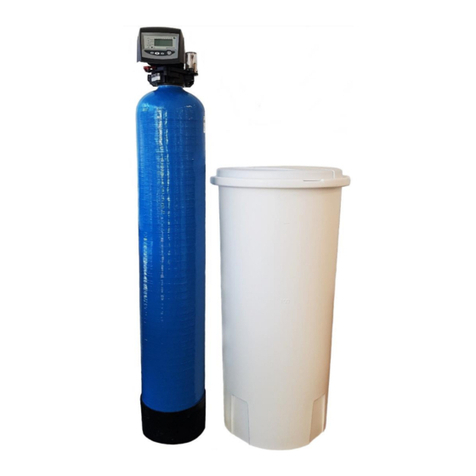
Strong Flow
Strong Flow AG Series Operating and maintenance instructions

vitapur
vitapur VWD9956BLS Specification sheet
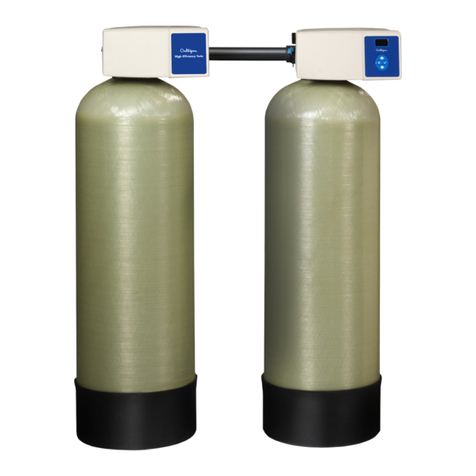
Culligan
Culligan High Efficiency 1.5 Twin Series Installation, operation and service instructions

Breville
Breville URN6 Instruction book
